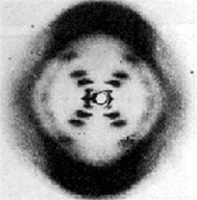Long-delayed Justice for a Remarkable Scientist
December 1, 2003

Rosalind Franklin
Book Review
Kathleen Williams
Rosalind Franklin: The Dark Lady of DNA. By Brenda Maddox, HarperCollins Publishers, New York, 2002, xix + 380 pages, $29.95.
Informed by thorough research, this timely biography at last does justice to the important scientific accomplishments of a remarkable young Englishwoman. In 1962 James Watson, Francis Crick, and Maurice Wilkins were awarded the Nobel Prize for their discovery of the structure of DNA. Until Maddox's book, however, Rosalind Franklin's contribution to the elucidation of DNA went essentially unacknowledged. This was in part because of Franklin's death of ovarian cancer in 1958 at the age of 37. But in larger measure, according to Maddox, the oversight was due to a combination of factors that dogged Franklin's entire life: her outspoken personality; the difficulties faced by women pursuing careers in science and their routine relegation to second-class status; the hostility of some of her male colleagues and superiors; and, most damaging of all in the end, the failure of Watson and Crick to properly acknowledge their debt to her.
Based in large part on Franklin's own letters as well as on extensive interviews with her friends, family, colleagues, and all the principal scientists with whom she was involved, this biography presents a well-balanced and judicious portrait of a brilliant, ambitious, sometimes difficult young woman. In engrossing early chapters Maddox sets the scene of the Jewish enclave in London into which Franklin was born. Maddox describes Franklin's close-knit family, her precocious childhood, her early academic promise, and her years at Cambridge University.

Rosalind Franklin's 1953 x-ray diffraction photograph of DNA. From Rosalind Franklin: The Dark Lady of DNA.
A brilliant experimentalist, Franklin ultimately received a PhD in physical chemistry from Cambridge and became a research chemist specializing in crystallography. Maddox describes Franklin's passion for France, her near-perfect French, and her happy years there as a research scientist in a government laboratory. It was in France that Franklin learned to employ x-ray diffraction to reveal the crystal structure of coal. As Maddox demonstrates, Franklin's contributions to scientific knowledge were varied and far-reaching, extending well beyond DNA. Over a span of a very few working years, she put forth a remarkable body of work in coal studies and in virus research, earning wide recognition. The list of her published papers would do credit to someone twice her age.
Although she was a compulsive worker, Franklin also treasured her time away from work. Interspersing her observations with quotes from Franklin's correspondence and with family photographs, Maddox demonstrates Franklin's love of the outdoors and her lifelong pursuit of strenuous mountain climbing, hiking, and camping holidays. According to Maddox, Franklin also loved clothes and dressed with quiet style and restrained good taste. Indeed, one of the few criticisms of this book is the somewhat too frequent description of Franklin's clothes. Maddox has a reason for mentioning them, but it does not become apparent until the end of the book. By that time this reader, at least, had tired of the repetitive and seemingly trivial digressions.
Apart from this very minor flaw, Maddox writes in a straightforward, readable style and she tells a good tale. Her very clear descriptions of complex scientific subjects make Franklin's work accessible even to the nonscientist. What should prove particularly interesting to all readers is Maddox's picture of the scientific communities in England, France, and America in the 1940s and 1950s. Her portrayal of the personalities involved, the academic rivalries, the careerism, and the politics of scientific research and publishing makes fascinating reading. Balancing the negative effect of blatant chauvinism on Franklin's career, Maddox demonstrates that Franklin also had the support of loyal students, colleagues, and influential mentors.
In the end, however, the major interest in Rosalind Franklin centers on conflicting accounts of her role in the discovery of the double-helix structure of DNA. Maddox argues convincingly that Franklin's research data and x-ray photographs, which Watson and Crick saw without her knowledge, were crucial to their discovery. Had she lived longer, Franklin would surely have defended her claim to be a co-discoverer of DNA. Had Watson and Crick been more forthcoming, she would not have needed to.
Kathleen Williams is a professor of history at Bronx Community College, CUNY.

